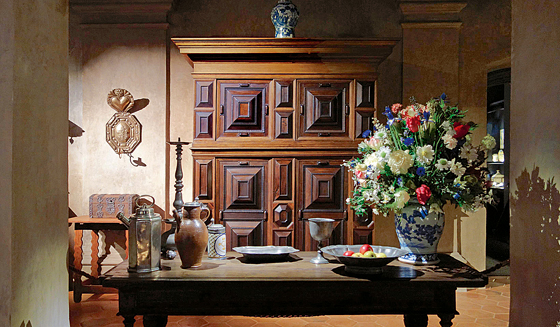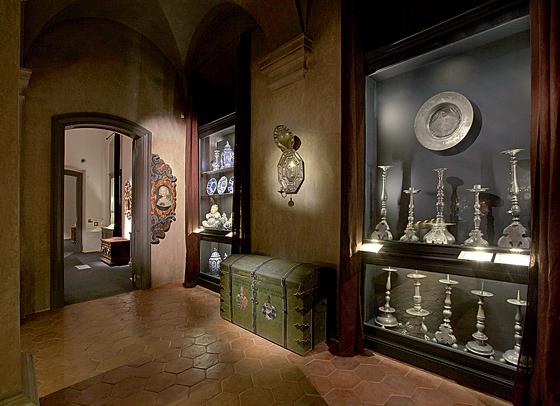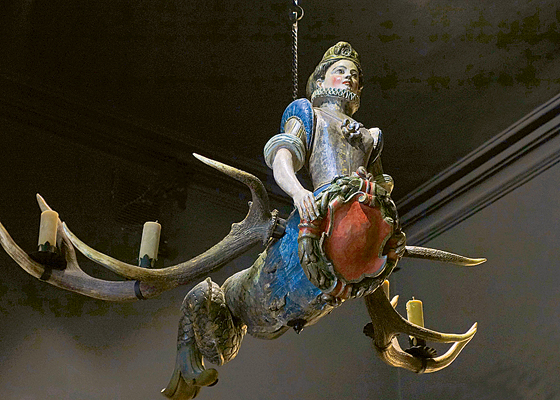|
|
| A night at the museum Katrīna Teivāne-Korpa, Culture Theorist | |
| I agree with Alise Tīfentāle, who once said in an interview that the use of the word “beautiful” with regard to contemporary art would be either risky or out of place. However, the tension that the word carries when applied to contemporary art is quickly defused on entering into an ancient manor house, castle or lavish museum with shelves full of shiny encrusted gold and silver goblets, neatly displayed embellished porcelain dishes, chests of drawers adorned with fine carvings and chairs upholstered in fabulous fabrics, with slightly dusty princess gowns hanging in the wardrobes and many more wondrous things, far from the daily routine, expecting us at every turn. Decorative art continues to surprise and fascinate with the craftsmanship of the artists, and the plasticity and splendour of the materials mastered, but the dense historical aura inspires us to go on an imaginary journey in time. One of the places in Latvia where to enjoy the splendour of times gone by is, of course, Rundāle Palace. Over a year ago, a new exposition of decorative art was opened there, offering a historical overview of various art styles from the Gothic up to Art Nouveau. Currently seven of the fourteen rooms dedicated to the exhibi- tion can be seen (the two most recent were opened for viewing on 24 May), but the last of the fourteen will be opened in 2016. The Rundāle Palace website informs us that the exhibition From the Gothic Style to Art Nouveau has been created to fill in, at least par- tially, for the absence of a museum of European decorative art in Latvia. | |
 View from the exhibition From the Gothic Style to Art Nouveau, Rundāle Palace Museum Photo: Imants Lancmanis Publicity photos Courtesy of Imants Lancmanis | |
| The first five exhibition rooms which I was able to view cover a period from the Late Gothic to late Baroque, and had on display samples of decorative art from Latvia, Germany, Italy, France and other Western European countries dating from the late 15th centu- ry even up to the 19th century. There is gleaming furniture set out in neat and harmonious interiors, portraits of the dukes and duchesses of Courland (Kurzeme), sacral objects, and, of course, fabu- lous china, kitchen items and similar treasures. One of the newly opened exhibition rooms showcases the sizeable Rundāle Palace collection of magnificent ceramics in the styles of Baroque, Rococo, and Classicism, spanning the entire 18th century. The room right next to it offers a display of Baroque ornamentation and religious art. The exhibition rooms opened next year will present examples of Rococo art in Latvia. “A beautiful and finely crafted piece of furniture emits harmony and peace, and it tells the tale of a time when everything around was art and only art.” 1 The organizer of the exhibition and director of Rundāle Palace, Imants Lancmanis, has often emphasized that particular care should be taken when exhibiting antique objects, creating a sym- metrical and stylistically appropriate composition that can be en- joyed as a whole. The exhibition From the Gothic Style to Art Nou veau not only allows the objects to shine collectively, but also to be appreciated as individual items. To a large extent this is achieved with the aid of a dark background. There is a black background in the glass showcases displaying the candle holders, dishes, gob- lets, ceremonial vessels and other items of historical significance, meanwhile the rooms (at least the five rooms that I saw) are very dimly lit, but the viewer’s eye is directed to the objects on display by beams of light, as in the theatre. Leading us out of the “darkness of history” and emphasizing the dramatic effect, the lighting gradually becomes brighter as you move from room to room. Such an approach definitely makes the visit unexpectedly interesting. When viewing exhibitions of historic decorative arts, we do not usually regard them with a critical eye. If we want to we can, of course, look at these masterpieces of craftsmanship and apply vari- ous contemporary methods of art critique (and a psychoanalytical approach can always be applied to anything). Most often, however, we stick to “like” or “don’t like”, or try to imagine whether a particu- lar item would fit in with the rest of the interior of our house, or vis- ualize a piece of jewellery in our own jewellery box, and in the best case, we might take a slight interest about a style, or in the longago events or historical figures that might have attracted our attention. First and foremost, it is a matter of visual enjoyment. No matter how engaging it may be, historical and doubtless significant facts tend to leave a rather unreliable impression on our memories. The reason I mention all this is because that is how I had imagined my visit – free of any other “preoccupations” – but the dusklike atmosphere and the visit as an intimate experience, as intended by the exhibition organizers, touched a strand of some inner turmoil in me (that is – reflection), which made its presence felt for a quite some time. | |
 View from the exhibition From the Gothic Style to Art Nouveau, Rundāle Palace Museum Photo: Imants Lancmanis Publicity photos Courtesy of Imants Lancmanis | |
| Since my visit to the museum took place during an extended win- ter which has stubbornly refused to go away, the palace was pleas- antly quiet and empty. The exhibition (there is a separate entrance fee) was opened “on request”. The first room, displaying works in the Gothic, Renaissance and Mannerism styles, immediately drew the few visitors into its nocturnal atmosphere, at once both surprising and intriguing in this situation. When the eyes adjusted, one could start to appreciate the items surrounded by the twilight, overall creating a mood of solemn awe. While standing at the rope barriers and in- tently staring at the objects displayed at the back of the room, some of them were difficult to see properly – either the beam of light did not quite reach them, or there was a shadow cast on them by an adjacent piece of furniture. Also, now and then a glass showcase seemed to merge with the everpresent shadow, creating a feeling that one had to go through the room very quietly, as if trying not to wake the in- habitants from their deep sleep. In this way the viewer was encouraged to overcome the constraints of time and space, and let them- selves be carried away by the magic of old times, but at the same time to keep a safe distance. It must be added that the shortcomings of the lighting will be resolved. There was another thing, though, and it was related to the lighting employed, which really made the viewer pay undivided attention to the exhibits...As you gazed, it made you feel as if there might be a continuation, a dialogue, not just a stream of your own associations and thoughts. There was hope that an object might start to “speak”, however, it was just not happening. In every room there were descriptions about the styles and countries represented, offering a general historic overview, as well as an introduction, using copies, to the main types of ornaments. The emphasis was on grotesque images with particularly expres- sive, mannerly tangled lines that would appeal to any fan of surrealism. Next to each item there was a brief and concise description, listing the function of the item, the date and country of its origin, and the name of the author, if known. Everything just so. Maybe at times the information offered presupposed some previous knowl- edge of the history of decorative arts and styles, but all in all, it did not differ much from other exhibitions and otherwise I would not worry too much about it. However, the theatrical effects, the “stage” prepared for the show and the exhibits ready for their cue seemed to almost demand more textual information, they created a desire to hear their stories and find out about their fate. Even though it finally became clear which rooms would be available for the exhibition only seven years ago, there is a much longer history behind its development that goes back to the 1960s, that is side by side with the restoration of the palace itself. Dur- ing the search for examples of Baroque interiors, museum staff acquired various objects, some older, some more recent, and over the course of the years the collection grew. The majority of the valuable items arrived at the museum in a very poor condition, and some of them have been undergoing restoration, with intervals between, for up to 30 years. Many items were salvaged from the manor hous- es and churches that were destined for demolition during Soviet times, or were acquired from the collections confiscated from the socalled “bourgeois” and in similar other ways, inconceivable in this day and age. Of course, the collection has been augmented also with carefully chosen objects purchased at recent auctions, and loans from other museums or churches in Latvia. The organizers of the exhibition have often played a quite personal part in the fate of the objects in the 20th century and could reveal more than one plot worthy of a detective story or adventure novel. I can imagine a walk through the exhibition From the Gothic Style to Art Nouveau, for instance, with the audioguide that is so common at museums in other countries, where the lord of the manor himself with his pleasant tone of voice and eloquent speech would accompany the viewer on an engaging journey, making every antique item on show come to life. Moreover, such an approach would not only provide an easier way for guests to absorb all the factual materials about the provenance of the exhibits, but would also offer a qualitative view on the relatively recent past of this country. After all, not only the expressions of modernism and the efforts in contemporary art during the Soviet period have something to say about all that. Sooner or later questions find their way to answers. Completely unexpectedly, I had a chance to speak to Imants Lancmanis in per- son about the exhibition. He shared several stories worthy of note, among them the story of the currently most valuable exhibit – the silver chalice from St. John’s Church; and the 17th century tapestry King Solomon and the Queen of Sheba, which was restored back to its splendour thread by thread. He also spoke about the dearth of medieval furniture in Latvia, and the story of the duchess of Courland, Elizabeth Magdalena, and the astonishing fate of the items in her possession, as well as many other infinitely interesting things. Each of the tales told is worth an essay of its own, and I hope that these and others will at some stage join the exhibits in the palace rooms, as that is their rightful place. The first object that attracts the viewer’s attention on entering the exhibition and – after thinking about it – the artefact that was also the initial reason for my “inner turmoil”, is the amazing medieval chandelier with a mermaid’s figure. To that I will devote a short concluding story. | |
 Chandelier with the figure of a mermaid. Latvia, Courland. 1596 Photo: Imants Lancmanis Publicity photos Courtesy of Imants Lancmanis | |
| Chandelier with a mermaid’s figure. Courland, 1596 (Written after a conversation with Imants Lancmanis) These types of chandeliers are extremely rare. They are mainly from the Gothic period and only a few have remained extant to this day. There is only the one specially created collection of medieval chandeliers in Switzerland. During the the Renaissance and Mannerism, these chandeliers went out of fashion and practically became obsolete. The chandelier with a mermaid’s figure is first of all interesting because it comes from the church of Gramzda. All the furnishings of the church were made in 1596, and we have several more items in our collection. In 1746–1747, during the Rococo period, the church un derwent reconstruction and the mermaid from the chandelier was transformed into a part of the baptismal font. During the Baroque period, baptismal fonts were often carved from wood, sometimes with carved figures, for example, angels holding the base of the font. If not being used for a christening, the baptismal font was raised to the roof of the church by means of ropes. It was a kind of pulley system: by pulling one wire the font came down, and by pull- ing the other wire, it went up. Usually there was also a cover for the font, this too was raised to the roof. This was put together in a so called “christening machine’, and all of this was to be found at the Gramzda church before the war. In the 1930s, the Monument Board transferred all the artefacts that the church no longer needed to the Liepāja Museum, in this way rescuing them. During the Second World War the Gramzda church was burnt down entirely. The only things that survived were the items that had been moved to the Liepāja Museum, and the museum donated the greater part to us about 35 years ago. We were looking at the mermaid and realized that it was not really a part of the baptismal font, but actually belonged to a chan- delier. If I am not mistaken, in 1934 an inspector of the Monument Board visited the church at Gramzda and recorded everything that he saw there. On the basis of his report, it was decided to move the artefacts to the museum. There is an interesting description about the altar, that it had a deer horn, painted in red and blue, attached to it. This made it all the more clear to us that when the chandelier was attached to the baptismal font in 1746, the horn was broken off, but instead of discarding it, they attached it to the altar. Apparently the Monument Board in the 1930s did not understand why there was a horn, moreover a painted one, attached to the altar, and thus it re- mained in the church and perished in the fire, unfortunately. We decided that we should piece together the medieval chandelier which would be the only one of its kind in Latvia, and we needed a deer horn. We were looking for it, just in case it had in a miraculous way ended up at the Liepāja Museum or some other place...The most interesting thing was that when researching similar chandeliers, there was never any reference to a painted deer horn. A deer horn is an essential part of these chandeliers. And there is always a figure. Often it’s the Madonna. Well, it a mermaid, too... Usually, it’s a real mermaid, but here we had a mermaid dressed like a fashionable lady of the time, with a collar, coiffed hair and a hat like they wore at that time, it was something incredible! Like nowhere else! And then, what’s more, a painted horn! Initially we thought that we would somehow work out how to paint it, but then we gave up and left it as it is now. We attached the deer horn guided by how other similar chandeliers had been made. Thus, in a way, we recreated the chandelier from scratch. The chandelier is essential to the first room, it leads the viewer into this mysterious world. The chandelier is there, as if flying towards the dark ceiling, and you immediately get this up lifting feeling. Of course, there is also that Mannerist touch: a crazy idea – imagine, a mermaid as a fashionably dressed lady. Translation into English: Vita Limanoviča 1 Pīra-Rezovska, Baiba. Apartment in the evening twilight. Deko, 2010, April-May, p. 34. | |
| go back | |







